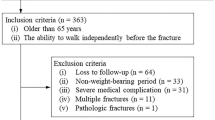Abstract
We investigated the factors influencing ambulation prognosis after hip fracture in the elderly patient and examined whether it is possible to predict the ambulation status upon hospital discharge at the time of admission. Two hundred and five patients aged 60 or older with a hip fracture who were ambulant before injury were studied. The patients were divided into two groups according to their ability to walk at the time of discharge from hospital: the ambulatory group and the non-ambulatory group. We assessed the value of various predictive factors. At discharge, 136 patients (66.3%) were ambulatory while 69 patients (33.7%) were non-ambulatory. Factors significantly affecting walking ability at discharge were: (1) age, (2) dementia, (3) residence before injury, (4) anaemia, (5) electrolyte abnormality, (6) abnormal chest X-ray, and (7) chronic systemic disease. Each patient was scored on the basis of the above factors (1=yes, 0=no), and the total was used as the predictive score. The mean score was significantly higher (p<0.0005) in the non-ambulatory group. It is possible to predict ambulation prognosis after hip fracture using our scoring system at the time of admission.
Résumé
Nous avons analysé les facteurs influençant le pronostic de la marche après fracture de la hanche chez les patients âgés en nous posant la question de la possibilité de prévoir, lors de l’admission, le statut du patient après sa sortie de l’hôpital. Ont été étudiés 205 patients âgés de 60 ans ou plus, avec une fracture de la hanche, patients « marchant » avant le traumatisme. Ces patients ont été divisés en deux groupes selon leur statut ambulatoire à la sortie de l’hôpital. Un premier groupe de patient autonome sur le plan de la marche et un deuxième groupe non-autonome. Sont sortis de l’hôpital 136 patients: 66,3% étaient autonomes sur le plan de la marche pendant que 69 patients (33,7%) n’étaient pas autonomes. Les facteurs significatifs affectant l’autonomie de la marche après la sortie de l’hôpital étaient l’âge, la démence, le statut résidentiel avant le traumatisme, l’existence ou non d’une anémie, les anomalies électrolytiques, la radio anormale du poumon et une pathologie systémique chronique. Chaque patient a été sérié selon ces facteurs (1=présence du facteur, 0=pas de présence du facteur), le total des différents facteurs donnant le score prédictif. Le score moyen était hautement significatif dans le groupe des patients non-ambulatoires. Il est donc possible de prévoir le pronostic de marche après une fracture de la hanche en utilisant ce score au moment de l’admission du patient avant le traitement de sa fracture.


Similar content being viewed by others
References
Cheng CL, Lau S, Hui PW, Chow SP, Pun WK, Ng J, Leong JC (1989) Prognostic factors and progress for ambulation in elderly patients after hip fracture. Am J Phys Med Rehabil 68:230–233
Cree AK, Nade S (1999) How to predict return to the community after fractured proximal femur in the elderly. Aust N Z J Surg 69:723–725
Hagino T, Harada J, Tonotsuka H, Ono T, Ishizuka K, Hamada Y (2003) Preoperative general condition and clinical prognosis after hip fracture. J East Jpn Orthop Traumatol 15:189–193
Hashmi MA, Tellisi N, Rigby AS, Wahab KH (2004) The value of a prognostic scoring system in the rehabilitation of elderly patients with proximal femoral fractures. Int J Clin Pract 58:2–5
Ichimura K, Ishii S (2001) Walking ability after surgical treatment of hip fractures in elderly patients; the risk factor analyzed by logistic regression. Seikeigeka (Orthop Surg) 52:1340–1342
Imai Y, Hasegawa K (1994) The revised Hasegawa’s dementia Scale (HDS-R) - Evaluation of its usefulness as a screening test for dementia. Hong Kong Coll Psychiatr 4:20–24
Ishida Y, Tsuchida S, Murata H, Kawai S (2003) Predictors of mortality and functional outcome of hip fractures in the elderly aged 90 years and over. Osteoporosis Jpn 11:219–223
Kitamura S, Hasegawa Y, Suzuki S, Sasaki R, Iwata H, Wingstrand H, Thorngren KG (1998) Functional outcome after hip fracture in Japan. Clin Orthop 29–36
Koval KJ, Skovron ML, Aharonoff GB, Meadows SE, Zuckerman JD (1995) Ambulatory ability after hip fracture. A prospective study in geriatric patients. Clin Orthop 150–159
Orimo H, Hashimoto T, Sakata K, Yoshimura N, Suzuki T, Hosoi T (2000) Trends in the incidence of hip fracture in Japan, 1987–1997: the third nationwide survey. J Bone Miner Metab 18:126–131
Richmond J, Aharonoff GB, Zuckerman JD, Koval KJ (2003) Mortality risk after hip fracture. J Orthop Trauma 17:53–56
Svensson O, Stromberg L, Ohlen G, Lindgren U (1996) Prediction of the outcome after hip fracture in elderly patients. J Bone Joint Surg Br 78:115–118
Thomas M, Eastwood H (1996) Re-evaluation of two simple prognostic scores of outcome after proximal femoral fractures. Injury 27:111–115
Wallace RG, Lowry JH, McLeod NW, Mollan RA (1986) A simple grading system to guide the prognosis after hip fracture in the elderly. Br Med J (Clin Res Ed) 293:665
Author information
Authors and Affiliations
Corresponding author
Rights and permissions
About this article
Cite this article
Hagino, T., Sato, E., Tonotsuka, H. et al. Prediction of ambulation prognosis in the elderly after hip fracture. International Orthopaedics (SICOT) 30, 315–319 (2006). https://doi.org/10.1007/s00264-006-0086-y
Received:
Accepted:
Published:
Issue Date:
DOI: https://doi.org/10.1007/s00264-006-0086-y




